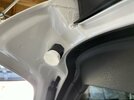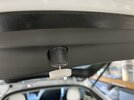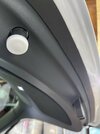Welcome to Tesla Motors Club
Discuss Tesla's Model S, Model 3, Model X, Model Y, Cybertruck, Roadster and More.
Register
Install the app
How to install the app on iOS
You can install our site as a web app on your iOS device by utilizing the Add to Home Screen feature in Safari. Please see this thread for more details on this.
Note: This feature may not be available in some browsers.
-
Want to remove ads? Register an account and login to see fewer ads, and become a Supporting Member to remove almost all ads.
You are using an out of date browser. It may not display this or other websites correctly.
You should upgrade or use an alternative browser.
You should upgrade or use an alternative browser.
Easy and effective low frequency fix
- Thread starter MY-Y
- Start date
jgrgnt
Member
Still haven't gotten around to making the ridged hatch stops, but today I drove our Model X for the first time in about two weeks. It has the low frequency booming, too! It's simply nowhere near as bad as in our Model Y, certainly not bad enough to notice in 70,000 miles of driving! That sort of reset my expectations. I've been reading up on all the different solutions to mitigate the boom, with the intention of eliminating it entirely. But now I realize that I can tolerate a minor amount of it. If I can get the Y to be as good as our X, that's enough for me.
Hoping to tackle the hatch stops this weekend. Fingers crossed...
(side note: our 2017 X has significantly more wind and road noise than the Y. Kudos to Tesla for improving their sound isolation over the years.)
Hoping to tackle the hatch stops this weekend. Fingers crossed...
(side note: our 2017 X has significantly more wind and road noise than the Y. Kudos to Tesla for improving their sound isolation over the years.)
Cool. Thanks!According to tirerack, that width is right in the middle of the acceptable range.
Don't forget that the stops do need to have some preload. My hatch pops when I open it.Still haven't gotten around to making the ridged hatch stops, but today I drove our Model X for the first time in about two weeks. It has the low frequency booming, too! It's simply nowhere near as bad as in our Model Y, certainly not bad enough to notice in 70,000 miles of driving! That sort of reset my expectations. I've been reading up on all the different solutions to mitigate the boom, with the intention of eliminating it entirely. But now I realize that I can tolerate a minor amount of it. If I can get the Y to be as good as our X, that's enough for me.
Hoping to tackle the hatch stops this weekend. Fingers crossed...
(side note: our 2017 X has significantly more wind and road noise than the Y. Kudos to Tesla for improving their sound isolation over the years.)
All depends on how much of an issue the booming is for you. I didn't really have an issue with mine, but did the tubing and the hatch stops just because I like projects.Do I still need to do the modified hatch stop If I can already readjust my hatch stop where it grips the envelope test pretty well?
PecuniaNonOlet
Member
The purpose of using modified hatch stops is to rigidize them. The OEM hatch stops are made of rubbery material that allows the hatch to vibrate, even when the hatch stops are correctly adjusted (as confirmed by the envelope test). This movement of the hatch is also what the vinyl tubing modification aims to correct. As JonB65 says, if you know or even suspect that your booming is coming from the hatch, it may be worth rigidizing your hatch stops and/or inserting vinyl tubing into the hatch gasket. Your goal is to hold the hatch so tight when it is closed that it can't move, even when driving over rough surfaces such as textured pavement.Do I still need to do the modified hatch stop If I can already readjust my hatch stop where it grips the envelope test pretty well?
jgrgnt
Member
Spent this weekend experimenting with a few solutions. My car has mild pressure buffeting and the low frequency "body boom." I was looking to address both and get them to the point where it no longer bothered me.
Here's what I did:
It took this combination to finally minimize the pressure buffeting to the point where I can no longer detect it. However, the low frequency booming is still present.
I asked my wife to drive the car while I sat in the passenger seat, thinking maybe the booming is stronger on my side of the car than hers (she thinks I'm crazy because she can't hear it). It's not. It's just as loud regardless of which seat you occupy in the front row. I then moved to the back seat and found that the booming is far less bothersome, maybe ~75% reduced in volume. So that's good news for passengers and children who ride in the back. They will be very comfortable! While back there, I placed my fingers in the gap between the hatch and the body while my wife drove over rough patches of road, and there's very little "wiggle", and thus no perceptible pressure buffetting. I suspect the added 1/8" rubber helped in this regard.
Lastly, I tried stuffing some thick pillows between the rear seat and the headliner, to block off as much of the trunk area as possible. This resulted in a slightly improvement, maybe 20%. I do wonder how much a thick cargo cover would help. I'm tempted to make one myself to try it out.
At this point, I probably need to go down the route of installing sound deadening in the hatch and in the quarter panels to address this to my satisfaction.
Some pics below of all three fixes:
Here's what I did:
- I used double-sided 3M tape to add 1/8" thick ultra stiff rubber around the perimeter of the hatch to create a tighter seal. I didn't want to risk damaging the original seal using the vinyl tube approach, and this implementation is fully reversible.
- I then fashioned and installed rigid stops at the outer flanks of the hatch using the method described in this thread. The original rubber stops are inserted as far as they can go, and the plastic ring tightened as much as possible. I then pressed the rigid cap onto that. It's very solid. I can press on the corner of the hatch when it's closed and it won't move at all.
- Finally, I added furniture sliders (the ones that you nail on) to the lower edge stops to stiffen them. These just press into the existing rubber stops and are easy to remove. On my car, the lower stops need to be extended pretty far to make good contact, so I was looking for a way to be able to retract them a bit and add stiffness.
It took this combination to finally minimize the pressure buffeting to the point where I can no longer detect it. However, the low frequency booming is still present.
I asked my wife to drive the car while I sat in the passenger seat, thinking maybe the booming is stronger on my side of the car than hers (she thinks I'm crazy because she can't hear it). It's not. It's just as loud regardless of which seat you occupy in the front row. I then moved to the back seat and found that the booming is far less bothersome, maybe ~75% reduced in volume. So that's good news for passengers and children who ride in the back. They will be very comfortable! While back there, I placed my fingers in the gap between the hatch and the body while my wife drove over rough patches of road, and there's very little "wiggle", and thus no perceptible pressure buffetting. I suspect the added 1/8" rubber helped in this regard.
Lastly, I tried stuffing some thick pillows between the rear seat and the headliner, to block off as much of the trunk area as possible. This resulted in a slightly improvement, maybe 20%. I do wonder how much a thick cargo cover would help. I'm tempted to make one myself to try it out.
At this point, I probably need to go down the route of installing sound deadening in the hatch and in the quarter panels to address this to my satisfaction.
Some pics below of all three fixes:
Attachments
Don't be surprised if the sound deadening doesn't help either. It did not for me. I did one layer of butyl and one layer of foam everywhere I could put it in the inside access to the quarter panels. I did not go through the wheel well.Spent this weekend experimenting with a few solutions. My car has mild pressure buffeting and the low frequency "body boom." I was looking to address both and get them to the point where it no longer bothered me.
Here's what I did:
The hatch "pops" open, so I know there's sufficient load on the seals and the stops.
- I used double-sided 3M tape to add 1/8" thick ultra stiff rubber around the perimeter of the hatch to create a tighter seal. I didn't want to risk damaging the original seal using the vinyl tube approach, and this implementation is fully reversible.
- I then fashioned and installed rigid stops at the outer flanks of the hatch using the method described in this thread. The original rubber stops are inserted as far as they can go, and the plastic ring tightened as much as possible. I then pressed the rigid cap onto that. It's very solid. I can press on the corner of the hatch when it's closed and it won't move at all.
- Finally, I added furniture sliders (the ones that you nail on) to the lower edge stops to stiffen them. These just press into the existing rubber stops and are easy to remove. On my car, the lower stops need to be extended pretty far to make good contact, so I was looking for a way to be able to retract them a bit and add stiffness.
It took this combination to finally minimize the pressure buffeting to the point where I can no longer detect it. However, the low frequency booming is still present.
I asked my wife to drive the car while I sat in the passenger seat, thinking maybe the booming is stronger on my side of the car than hers (she thinks I'm crazy because she can't hear it). It's not. It's just as loud regardless of which seat you occupy in the front row. I then moved to the back seat and found that the booming is far less bothersome, maybe ~75% reduced in volume. So that's good news for passengers and children who ride in the back. They will be very comfortable! While back there, I placed my fingers in the gap between the hatch and the body while my wife drove over rough patches of road, and there's very little "wiggle", and thus no perceptible pressure buffetting. I suspect the added 1/8" rubber helped in this regard.
Lastly, I tried stuffing some thick pillows between the rear seat and the headliner, to block off as much of the trunk area as possible. This resulted in a slightly improvement, maybe 20%. I do wonder how much a thick cargo cover would help. I'm tempted to make one myself to try it out.
At this point, I probably need to go down the route of installing sound deadening in the hatch and in the quarter panels to address this to my satisfaction.
Some pics below of all three fixes:
MyEarHurts
Banned
Agree with Noflash, I put like 4 layers and 5 in some to include the wheel wells and while it’s quieter in road noise a little bit, it did not help the boominess that much. I really think it has to do with the roof or the cargo cover because when I had the model 3 for a loaner, it was barely if even noticeable.
jgrgnt
Member
Update: pressure buffeting still there. Drove over a stretch of socal highway and the concrete expansion joints must have been perfectly spaced. This time, my wife noticed right away. Saw her cover her ears. It was not pleasant.
Back to square one…
Back to square one…
Consider removing the mods except for the rigid stops. Make sure they are what us pushing on the hatch to make it pop.Update: pressure buffeting still there. Drove over a stretch of socal highway and the concrete expansion joints must have been perfectly spaced. This time, my wife noticed right away. Saw her cover her ears. It was not pleasant.
Back to square one…
I had both buffeting and low frequency resonance and they are not related. You can actually feel the buffeting if you sit in the cargo space and touch the rear glass on hatch while someone else is driving the car over potholes etc. Vinyl tubing fixed that, and no amount of rigid stop adjustments helped before I added vinyl.Update: pressure buffeting still there. Drove over a stretch of socal highway and the concrete expansion joints must have been perfectly spaced. This time, my wife noticed right away. Saw her cover her ears. It was not pleasant.
Back to square one…
The low frequency resonance comes from metal panels and wheel wells and you need to add butyl and maybe foam to fix it (I added both). After fixing both, I took 600 miles trips with no ear pressure or headache. It still not a Lexus and has stiff suspension but I am not committing to coilover yet.
I fixed it for you.I feel like Tesla should have a service where they solve people's Model Y noise issues. Figuring out the right combination of hatch adjustments, sound deadening material, etc. I paid good money for that...
Finally got 255/55-18 Quatrac Pros. Only just drove 10 minutes home from Discount Tire with the Gemini clanging in the back, but it seems moderately better.
Last edited:
PecuniaNonOlet
Member
I
I have ordered those tires in 255/45R20. I'm interested in hearing how the road noise is. I'll be swapping them as soon as my OEMs wear down, or before next winter, whichever comes first.I'm interested to hear more as I'm still on the stock tires.
Well, Discount Tire only pumped them up to 37 psi, I'll remedy that tomorrow. The handling feels a little looser, but we are also having a wind storm today. When I drove out of the DT lot, I was surprised that I noticed the road noise right away. I have not noticed it since though. I may have had big ears on. I was also surprised how much I still hear the booming. Still it is "moderately" less. I'm not going to attempt to put a percentage on it. It is certainly not soft or subtle over bumps. It's a little better. I'm mildly disappointed, but I'm thankful I didn't spend more on the wheels. These were $169 each. I'm happy I'll have better tires for winter.
I did notice the back end kick out when turning from a stop. I'm assuming the tires need to break in a little.
Sorry for all the caveats and disclaimers. I need more air in them and more time with them for a better report.
I did notice the back end kick out when turning from a stop. I'm assuming the tires need to break in a little.
Sorry for all the caveats and disclaimers. I need more air in them and more time with them for a better report.
ilovecoffee
Member
In my past experience lower tire pressure seemed to add to boominess. Perhaps more contact with the road. Or maybe it was something else.Well, Discount Tire only pumped them up to 37 psi, I'll remedy that tomorrow. The handling feels a little looser, but we are also having a wind storm today. When I drove out of the DT lot, I was surprised that I noticed the road noise right away. I have not noticed it since though. I may have had big ears on. I was also surprised how much I still hear the booming. Still it is "moderately" less. I'm not going to attempt to put a percentage on it. It is certainly not soft or subtle over bumps. It's a little better. I'm mildly disappointed, but I'm thankful I didn't spend more on the wheels. These were $169 each. I'm happy I'll have better tires for winter.
I did notice the back end kick out when turning from a stop. I'm assuming the tires need to break in a little.
Sorry for all the caveats and disclaimers. I need more air in them and more time with them for a better report.
Similar threads
- Replies
- 95
- Views
- 25K
- Replies
- 127
- Views
- 19K
- Replies
- 10
- Views
- 7K
- Replies
- 9
- Views
- 3K





